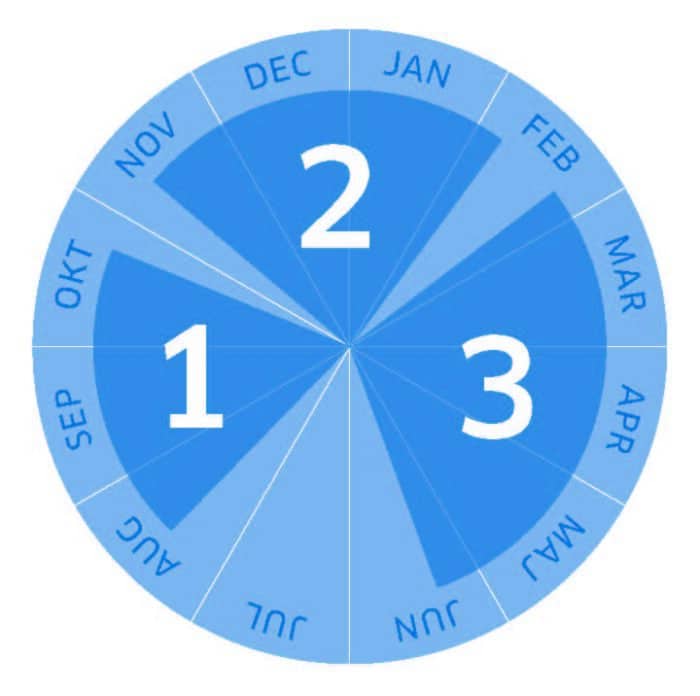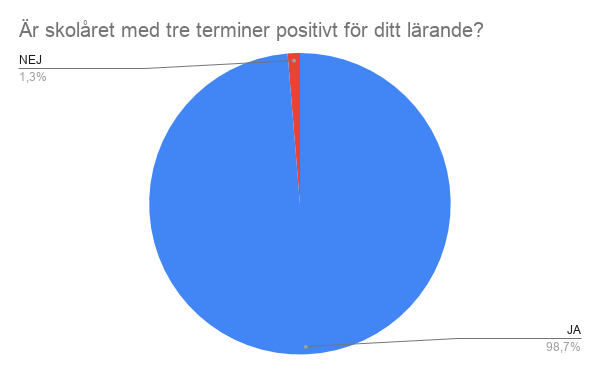Amerikanska Gymnasiet is the first high school in Sweden where the school year is divided into three semesters instead of two. Our students have 178 school days just like all other high school students in Sweden and they have the same number of hours of teaching. The difference is that our school year consists of three semesters to give students and teachers the highest pedagogical benefit with balanced year allowing them space and time both for growth and recuperation.
A bygone time
The traditional Swedish school year had its origins in a social structure dating back to 1842 and the old agrarian society. There was no pedagogical theory behind dividing the school year into two semesters but instead this arose from the needs of nineteenth century society. These structures have in principle remained in place since then and are still found in today’s Swedish schools, in spite of the fact that there is extensive scientific support for changing the school year. There has been no pedagogically planned organization of the school year with a focus on students’ learning processes and on the students themselves for almost 200 years.
(White 1908, Entwisle & Alexander 1992, Downey, von Hippel & Broh 2004, NIE 1978, Cooper, Nye, Charlton, Lindsay och Greathouse 1996, Pelavin & David 1977, Hattie 2009, Alinder, Hamlett & Fuchs 1992, Cooper 1996, Alexander, Entwisle & Olson 2001, Lindahl 2001, Moore 2010 etc.)
Summer vacation – was first introduced to meet demands that children help with the harvest
Fall break (fd formerly potato break) – was introduced to allow children to help with the potato harvest
Christmas and Easter breaks – were introduced for religious celebrations
Winter sports break – was introduced in order to save fuel
Study days – were introduced to allow further training for teachers
A pedagogical school year
The changes made to the school year by Amerikanska Gymnasiet allow periods of focused studies followed by periods of rest and reflection, strengthening both students and teachers throughout the school year. It is not a question of when the school days are actually placed in the calendar but of how the school days are distributed to make an underlying pedagogical structure for learning and teaching evaluation. It is also about managing recuperation for students and teachers during the school year at strategically chosen periods and for suitable lengths of time.

More accurate assessments
The first and second semesters always end with a two-week break. The grade forecasts for all the school’s courses are published in the week before the break. This is also when student-teacher conferences are held where students can book appointments with teachers they want to talk to about their schoolwork.
All grades are set after the third semester. This means that the structure of the school year is far clear and holds no surprises for our students. It also means that students have a better chance to reach the higher goals in the courses.
Positive trends in the learning experience
How students and parents and guardians experience the three-semester school year tells its own tale. A school year thoughtfully organized to promote learning has a major effect on schoolwork and recuperation
When we ask our students, 98.7% say that the three-semester school year has a positive effect on their learning. 98.1% of parents and guardians say that the three-semester school year has a positive effect on their children’s learning.

Recuperation and holidays
Breaks in the school year are generally two weeks long. This makes a clear symmetry in the school year. We have no study days spread out over the school year but incorporate study days into the fall break and winter sports break.
Fall break – 2 weeks
Christmas break – 2 weeks+ (as in other schools)
Winter sports break – 2 weeks
Easter break – 1 week+ (as in other schools)
Summer vacation
The summer vacation is nine weeks long which is one week shorter than other schools. We start each school year on the Tuesday of the second week in August. A nine week vacation is still too long for a vacation and it is a challenge for the students to retain everything they have learned. Students may attend a Summer Academy in a voluntary “fourth semester”. For those students who choose, the nine week summer vacation can be 3 weeks vacation – 3 weeks High School in the USA – 3 weeks vacation.
Teaching three semesters
Working with three semesters provides opportunities for planning and evaluating teaching. Working together with one another and continually developing are also two important cornerstones in our work. Fall and winter sports breaks that are two weeks long give teachers the opportunity to work together, to develop and to rest between semesters.
In spite of some peaks, the pedagogical work is far more evenly spread over the year when grades are only set in June and the system for grade forecasts and reviews is built into the yearly structure. These conditions enable us to teach with enthusiasm and energy right up to the Christmas break and all the way to the summer vacation and to make the best use of all the teaching hours.
